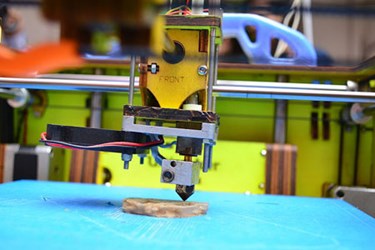3D Printing Provides Patient With New Pelvis
By Joel Lindsey

A surgeon in England has successfully used 3D printing to create a replacement pelvis for a man who had lost half of his original pelvis during cancer treatment.
According to The Gazette, the 3D-printed replacement pelvis is the first of its kind ever used in such a procedure.
Craig Gerrand, a consultant orthopedic surgeon at Newcastle upon Tyne Hospitals NHS Trust, performed the implant operation on the unnamed 60-year-old cancer survivor. The man had suffered from a rare form of bone cancer called chondrosarcoma.
“The cancer affected virtually the whole right side of the pelvis,” Gerrand said. “Since this cancer does not respond to drugs or radiotherapy, the only option to stop it spreading was to remove half of the pelvis.”
Without complete pelvis reconstruction, Gerrand explained, the patient would have been left with a “hanging” leg, unattached to the spine. Given the unique situation of the patient, Gerrand proposed using 3D printing to generate an entirely new pelvis.
“[The pelvis implant] was covered by a mineral into which the remaining bone cells could grow,” The Gazette reported. “This procedure was followed by a standard hip replacement, which fitted seamlessly into the titanium socket.”
Although the patient has not issued any personal statements, it has been reported that he can successfully walk with the new pelvis, with the help of a walking stick.
Reports of the pelvis replacement have generated a great deal of speculation regarding the potential of 3D printing for medical applications.
In a recent article, Rhiannon Williams of The Telegraph said, “Bioprinting, or the process of creating human tissues through 3D printers, is a highly contested area of technology innovation.” She added, “Theoretically it could save the economy billions on a global scale, [while] boosting weak or war-torn countries’ access to more affordable health care and provision, whether producing prosthetic limbs or highly customized fully working human organs.”
Despite the excitement many have expressed over the prospects of this technology, however, 3D printing is not without opposition.
“Ethically and morally, concerns have been raised over ensuring the quality of the organs, and who controls the right to produce them,” Williams said. “Others claim 3D printing human components further blurs the line between man and machine, giving us the right to ‘play God’ on an unprecedented scale.”
For surgeons like Gerrand who are focused on helping patients overcome cancer, 3D printing is not the ultimate goal.
“It’s fantastic that you can do cool surgery,” Gerrand said. “But the real innovation will be when we don’t have to do this at all, because we have developed new treatments that can stop the cancer in its tracks.”
Image credit: "Printing with a 3D Printer at Makers Party Bangalore.” Panigrahi, Subhashish. © 2013 under Attribution-ShareAlike 3.0 Unported: http://creativecommons.org/licenses/by-sa/3.0/deed.en
